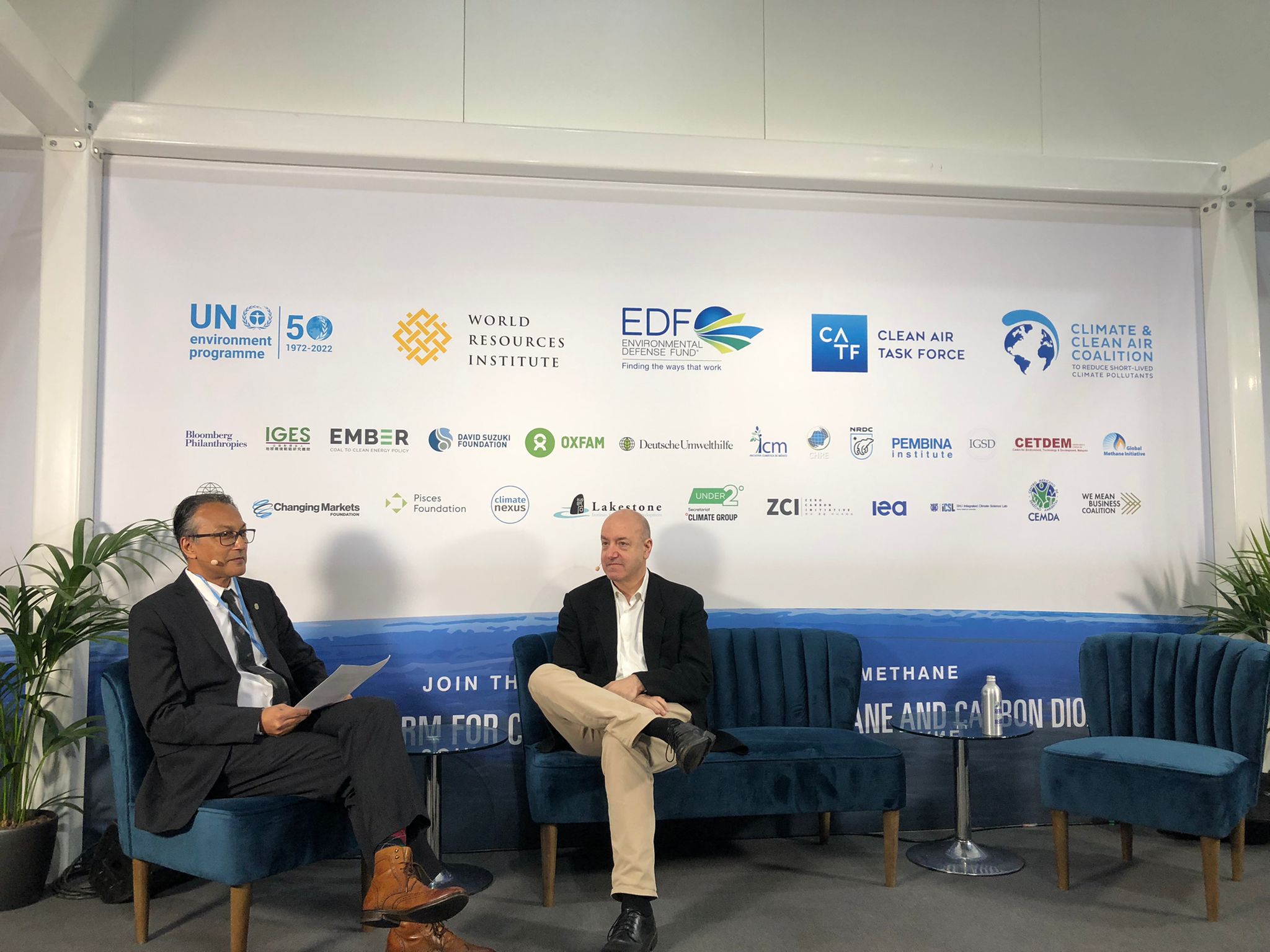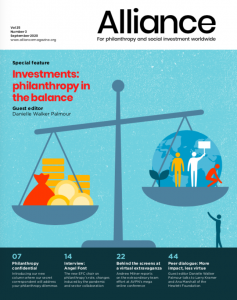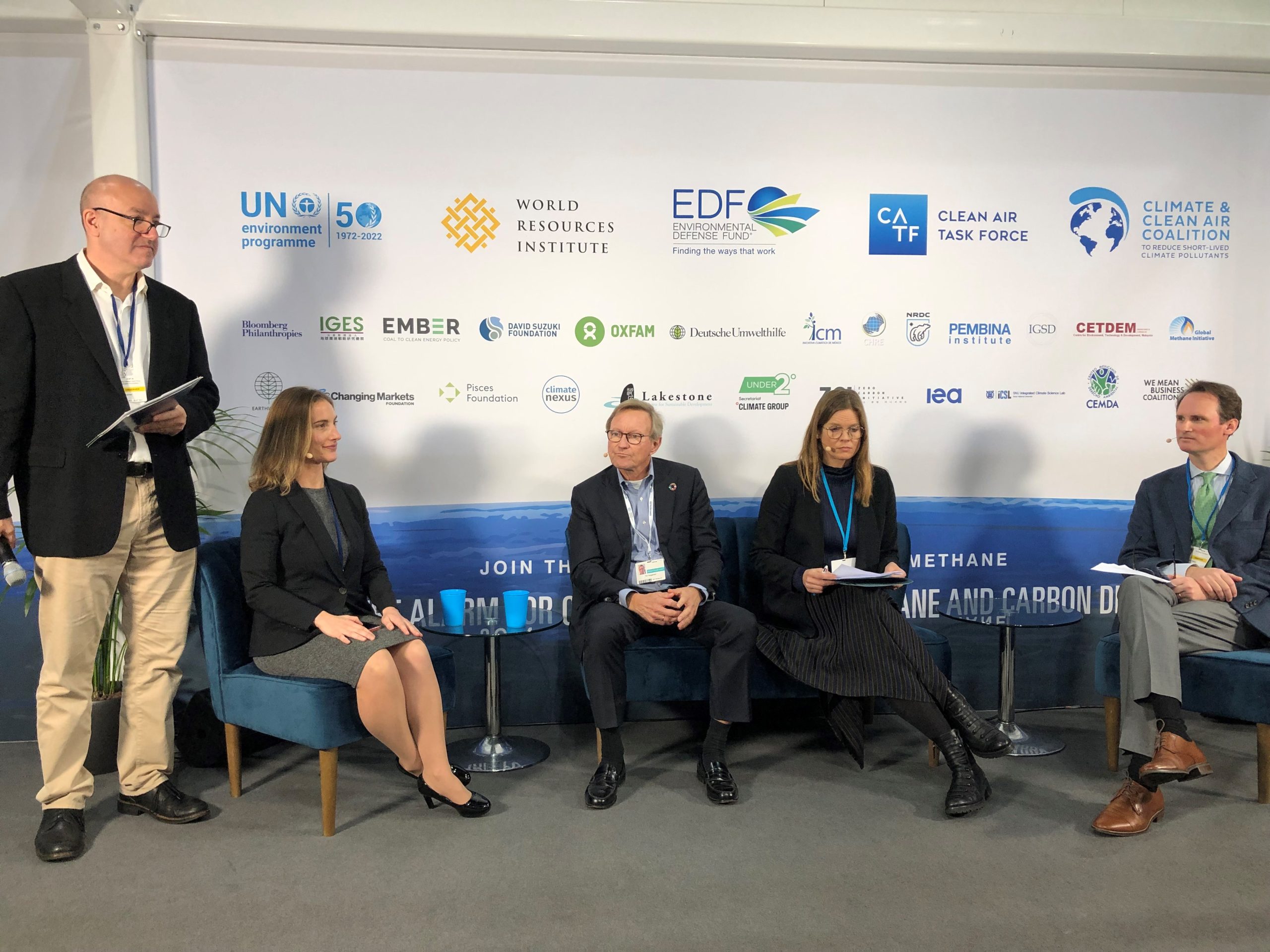GLASGOW – The Hewlett Foundation has traditionally been one of the biggest and longstanding funders in the climate philanthropy space, but this year they are asking their board to increase their budget by 40 per cent.
That’s how much the climate funding space has grown in recent years, Larry Kramer – President and CEO of the Hewlett Foundation – tells me.
‘We’ve gone from being the largest [climate] funder in the world in 2007 to having a number of funders that are larger than us, even though we’ve increased our budget,’ Kramer says.
We are sitting in the Methane Pavilion, which is a small set up in the exhibition centre that will host conversations on the effects of methane over the two weeks of COP26. Methane, which comes from energy, industry, agriculture, land use, and waste management, is at least 80 times as effective as trapping heat as carbon dioxide, but crucially it can dissipate in the atmosphere in a matter of years, which makes reducing it one of the more effective ways to reduce warming.

From left: Ani Dasgupta (WRI) speaks to Larry Kramer (Hewlett) at the Methane Pavilion in Glasgow during COP26.
On the morning I am there, leadership from some of the most well-known names in climate philanthropy will speak about the $328 million Global Methane Pledge, an initiative supported by philanthropy, in collaboration with US and EU administration, to promote public action on reducing 2020 methane emissions levels by 30 per cent by the year 2030. So far, over 100 countries have signed on – though there are notable absences like China, India, and Russia, the world’s top three emitters of methane.
The Methane Pledge is an example of philanthropy’s growing influence in the sphere of global climate action. That same day, CIFF’s CEO Kate Hampton will speak about how philanthropy’s work on this pledge comes out of the playbook of the 2016 Kigali Amendment, a philanthropy-backed initiative that successfully led to a reduction in the production of potent hydrofluorocarbons (HFCs), the greenhouse gases commonly used in cooling appliances like air-conditioners and refrigerators.
‘We’re now doing something bigger and faster,’ Hampton says.
It’s not just philanthropy’s part in the Methane Pledge that is bigger and faster this time – overall, the sector’s influence has grown rapidly over the past decade. To understand the story of how philanthropy ended up on the COP stage, I want to talk to Kramer, who’s been here all along.
On the role of philanthropy
‘So, there are a couple of different things I think philanthropy does really well,’ Kramer says when I ask him about the role of philanthropy at these big international summits.
‘One is, we can actually move quickly. Especially if you don’t need a lot of money. $328 million seems like a lot of money, but’s actually pennies compared to the billions that we need, but what philanthropy can do is deploy it quickly, which can catalyse things that bring in a lot more money.’
The Kigali Amendment is the perfect example of this – 18 funders committed $53 million in 2016 to kickstart action on curbing and capturing HFCs. Though the sum wasn’t great in comparison to what governments would put up, the offer of free capital proved enough to eventually bring 127 nations on board. It’s now estimated that the Amendment will contribute to reducing warming by 0.5°C.
Does he think there will be more public-private partnerships like the Kigali Amendment and the Methane Pledge?
‘I hope so. There are great opportunities, and when it works, it works really well.
‘I think what you’ll see more of that we have not seen much is a lot more philanthropy partnering with finance. And that has been almost non-existent and one of the things you see in this COP, there’s a huge growth of interest in banks, in financial institutions and they need help. You’ve got a ton of people committing to net zero, you know, and they have no idea how to do this. So, they’re going to need support. I think there are amazing opportunities for philanthropic private sector partnerships around that as well as government.’
And there’s a lot of knowledge on this in philanthropy, Kramer says, coming back around to the role of the sector in big international policy spaces like COP.
‘There is really deep expertise in the NGO world, which is what philanthropy funds. And we can play a role in connecting the NGO world to the business world or the government world, to help them have the expertise for implementation.
‘And again, it’s so remarkable when you think about how little money it takes to have those kinds of out-size effects.’
On increasing funding

This is an idea Kramer has expressed to Alliance before. Speaking to Danielle Walker Palmour, in September 2020 for an issue on investments, he said about Hewlett’s climate spending: ‘Increasing our funding would not make a big enough difference. It’s not more money alone that we need, but more people, more funders with new ideas and approaches and capacities.’
I point out that it seems like now there are more funders, more ideas, and new approaches. And of course – that Hewlett is now increasing their budget by 40 per cent.
‘You know, right after that conversation, we created The Climate Leadership Initiative,’ Kramer says. ‘We invested $10 million then, and we just put another $10 million into that. It’s brought in several billion. To me, that’s much more effective.’
There’s nothing worth doing in philanthropy that you can do alone, no matter how big you are.
The Climate Leadership Initiative, founded in 2019, is an advisory service for new climate philanthropists as well as strategic support to help experienced climate funders enlist their peers.
And the increase in Hewlett’s budget?
‘It’s mostly to retain our position in the field, our voice. It’s not because I think that extra money is going to make some massive difference in keeping the globe on track to the Paris target. But still, to retain our influence in our ability to help move the field and to participate actively with all the partners, we needed to increase our spending,’ he says.
‘And to be frank, with so many new funders coming in, the competition for talent has increased significantly, and I need to be able to hire program officers and give them discretionary funds,’ Kramer adds.

Kramer (left) introduces a panel with Per Heggenes (IKEA), Kate Hamton (CIFF), and John Palfrey (MacArthur) discussing the Methane Pledge at the Methane Pavilion in Glasgow.
On Bezos
One of the biggest, newest figures in the climate philanthropy space – whose foundation has almost certainly contributed to the hunt for talent – is the $10 billion Bezos Earth Fund. Due to spend down by 2030, the Earth Fund has added a new element to the world of climate philanthropy.
Bezos has a high profile at COP26. He flies in on a private jet, speaks to world leaders, and commits $2 billion to restoring natural habitats. Over the week I am in Glasgow, I try to get a gauge from some of the funding representatives I speak to what they make of Bezos’ philanthropy. The reactions are vague: they’re encouraged by the leadership he’s hired so far (Andrew Steer, previously World Resources Institute, and Charlotte Pera, previously ClimateWorks), they think that he seems to be listening to feedback with where the grants should be going, but overall, it’s still too soon to tell.
(Though it’s true that two years may be too soon to understand the shape of Bezos’ philanthropy – for the Earth Fund, one-fifth of its time to spend its $10 billion has already passed.)
‘Nobody yet has a sense of what his philanthropy is actually going to look like,’ Kramer says, echoing his colleagues. ‘They’re doing some early big bets so to speak, but I think it remains to be seen.’
On what’s changed since Paris
Though Bezos has been one of the splashiest new funders, the Earth Fund is far from the only new climate funder in recent years. What has it been like for the Hewlett Foundation, who has been in this space for a while?
‘I mean it is striking to me the difference between Paris and here. Paris was all about philanthropy, NGOs, advocacy… this is all about finance and business,’ he says.
‘Now you have these massive new pools of capital coming in, but they’re just coming in. The hope will be to work with them on our side and have them push us to some new thinking, and on their side to actually understand a lot better how this works.’
He continues: ‘There’s a whole lot of people kind of walking around with silver bullet thinking, and one of the lessons you learn is there are no silver bullets. You can make a lot of progress, but it’s ecosystem-building and so on. So, I’m hoping that there are some partnerships where, as I say, we can bring our most valuable resource, which has never been our money, it’s always been the experience and knowledge. And that comes back to the idea of working collaboratively and in partnership – that’s what you need.
‘That’s true for all philanthropy, by the way, there’s nothing worth doing in philanthropy that you can do alone, no matter how big you are.
‘But we’ll see. It’s the very beginning, a lot of new announcements here from people who, you know, they don’t know how to do what it is that they just set out to do. And the question is whether they’ll go through the process of making a lot of mistakes or want to start by working with people who have the experience, knowledge, and networks to do it better.’
On divestment
Something the Hewlett Foundation has been criticised for in the past is its hesitation to commit to divesting its $13.3 billion endowment from fossil fuels. It’s something Kramer has spoken about to Alliance before, but since then, the number of Hewlett’s peers in the foundation world announing their own plans to divest have grown. I ask him if anything has changed.
‘It’s really complicated,’ Kramer says. ‘But the short answer is this: the question is always impact.
$328 million seems like a lot of money, but’s actually pennies compared to the billions that we need, but what philanthropy can do is deploy it quickly, which can catalyse things that bring in a lot more money.
‘If divestment would have more impact than grantmaking, then you should absolutely divest. If it wouldn’t, then you’re cutting off your nose to spite your face. That has always been my view.
‘There is a difference between the Hewlett Foundation divesting and a multitrillion-dollar sovereign wealth fund divesting. And I have always said to my board, there’s no point for us to lead on this, because we’re not likely to have any political impact. Like, “the Hewlett Foundation is divesting!” – that’s not going to move markets or governments. But as it starts to develop as a movement, potentially the impact increases.’
On climate commitments
One growing part of the climate philanthropy space recently has been the number of commitments for philanthropy. The International Philanthropy Commitment on Climate change, hosted by WINGS, launched just before COP26 – but it follows a number of national commitments from the UK, Spain, Italy, France, and Canada, among others.
The commitments aim to bring together funders, including those who haven’t traditionally worked in the climate space, to help them apply a climate lens to their activities, set out guiding principles and pillars, and offer a mechanism for reporting.
Yet in reviewing these commitments, the language is often vague, the uptake of foundations that sign small, and the mechanisms for accountability non-existent. Are they useful?, I ask.
‘I’d rather have them than not have them,’ Kramer says, then offering an analogy that can perhaps apply to the COP agreements overall.
‘You know, think of it like: I have friends who live together and won’t get married, and you say to them: why not get married? And they say, what does it add? You know? And the truth is a public commitment, which is what a wedding is, actually adds something. It changes the nature of the relationship.
‘So, making public commitments does count for something. Nobody makes them and then you know just actually does nothing, they do more,’ he says.
And on accountability?
Kramer says: ‘What I think you’ll be seeing as we go forward is increasing creation of monitoring and tracking mechanisms that will be then holding people to account. That will be across the board, whether it’s philanthropy, business, or governments.’
Bringing it back to the Methane Pledge, he says: ‘You know, on the Methane Pledge, there’s a whole lot of building of ways to actually monitor and track and hold accountable people to the pledges that they made, whether its funding commitments or action or reductions.’
Elika Roohi is the Digital Editor at Alliance.






Comments (0)